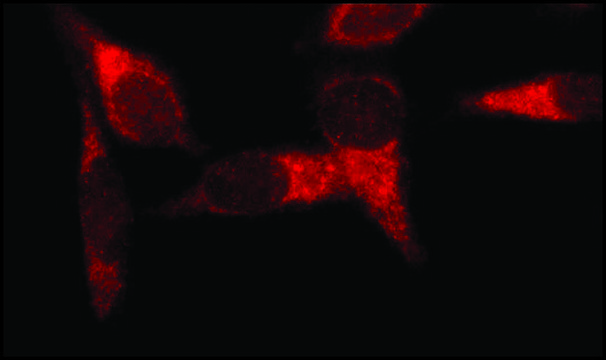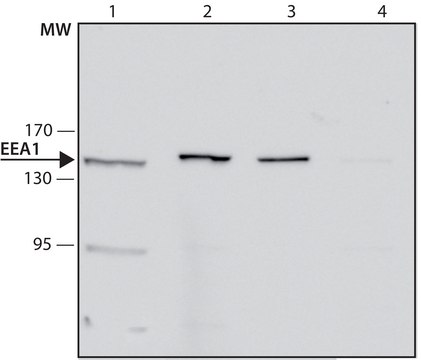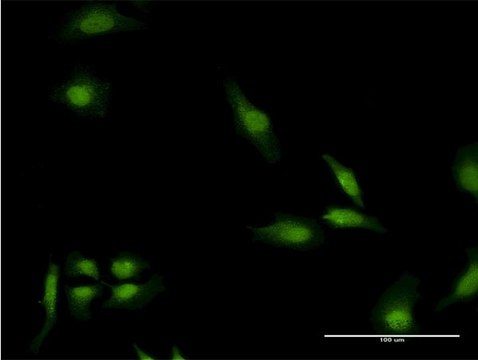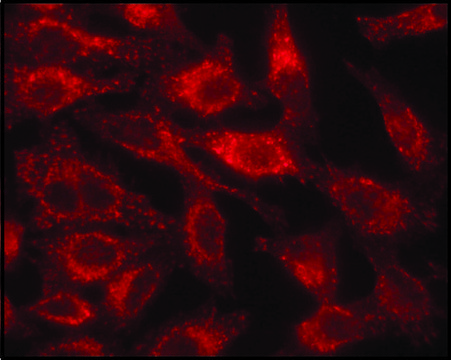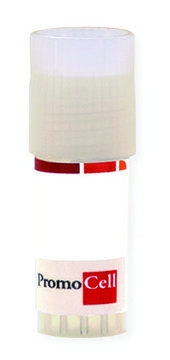推荐产品
生物来源
rabbit
质量水平
偶联物
unconjugated
抗体形式
affinity isolated antibody
抗体产品类型
primary antibodies
克隆
polyclonal
表单
buffered aqueous solution
分子量
antigen ~160 kDa
种属反应性
mouse, rat, human
浓度
~1 mg/mL
技术
indirect immunofluorescence: 5-10 μg/mL using rat NRK cells
western blot (chemiluminescent): 0.1-0.2 μg/mL using whole extract of human HeLa cells
western blot (chemiluminescent): 0.2-0.4 μg/mL using whole extract of mouse NIH3T3 cells
UniProt登记号
运输
dry ice
储存温度
−20°C
靶向翻译后修饰
unmodified
基因信息
human ... EEA1(8411)
mouse ... Eea1(216238)
rat ... Eea1(314764)
一般描述
Anti-Early Endosomal Antigen 1 (C-terminal), is produced in rabbit using a synthetic peptide corresponding to amino acid residues 1391-1410 of human EEA1, conjugated to keyhole limpet hemocyanin (KLH), as immunogen. Early Endosomal Antigen 1 (EEA1) is a 162 kDa autoantigen, which encodes for around 1400 amino acid proteins. EEA1 is a dimer, which comprises extensive coiled-coil regions. At its C-terminus, it contains a cysteine-rich zinc-finger-like domain named FYVE domain. The gene Early Endosome Antigen 1 (EEA1) encodes for around 1400 amino acid proteins
免疫原
synthetic peptide corresponding to amino acid residues 1391-1410 of human EEA1, conjugated to KLH. The corresponding sequence is identical in mouse.
应用
Anti-Early Endosomal Antigen 1 (C-terminal) antibody produced in rabbit has been used in:
- fluorescent staining
- confocal laser scanning microscopy
- immunoprecipitation
- indirect immunofluorescence microscopy
- fluorescence microscopy
- immunoblotting
- immunofluorescence.
生化/生理作用
Anti- Early Endosomal Antigen 1 (EEA1) may be used as an early endosome marker. The binding of EEA1 to phosphatidylinositol 3-phosphate (PtdIns3P) and Rab5-GTP is essential for the localization and function of EEA1 in endocytic membrane fusion. It is associated with subacute systemic lupus erythematosus that specifically localized to early endosomes.
The gene Early Endosome Antigen 1 (EEA1) encodes for around 1400 amino acid proteins. It is a peripheral membrane protein associated with the cytoplasmic side of early endosomes. EEA1 controls vesicle fusion during endocytosis. In neurons, it is involved in recycling of synaptic vesicles and neurotransmitter receptors. Patients with neurological deficits develop EEA1 autoantibodies. Mutation in EEA1 gene leads to susceptibility to diabetes in the Japanese population.
外形
0.01M 磷酸缓冲盐溶液,pH 7.4,含 15mM 叠氮化钠。
免责声明
Unless otherwise stated in our catalog or other company documentation accompanying the product(s), our products are intended for research use only and are not to be used for any other purpose, which includes but is not limited to, unauthorized commercial uses, in vitro diagnostic uses, ex vivo or in vivo therapeutic uses or any type of consumption or application to humans or animals.
未找到合适的产品?
试试我们的产品选型工具.
储存分类代码
10 - Combustible liquids
WGK
WGK 3
闪点(°F)
Not applicable
闪点(°C)
Not applicable
个人防护装备
Eyeshields, Gloves, multi-purpose combination respirator cartridge (US)
法规信息
新产品
历史批次信息供参考:
分析证书(COA)
Lot/Batch Number
Intracellular Trafficking of AIP56, an NF-kappaB-Cleaving Toxin from Photobacterium damselae subsp. piscicida
Pereira LMG, et al.
Infection and Immunity, 82(12), 5270-5285 (2014)
Retrieval of a metabolite from cells with polyelectrolyte microcapsules
Studer D, et al.
Small, 6(21), 2412-2419 (2010)
FYVE Domains in Membrane Trafficking and Cell Signaling
Handbook of Cell Signaling, 1111-1121 (2010)
The tumor suppressor DiRas3 forms a complex with H-Ras and C-RAF proteins and regulates localization, dimerization, and kinase activity of C-RAF
Baljuls A, et al.
The Journal of Biological Chemistry, 287(27), 23128-23140 (2012)
Angela Baljuls et al.
The Journal of biological chemistry, 287(27), 23128-23140 (2012-05-19)
The maternally imprinted Ras-related tumor suppressor gene DiRas3 is lost or down-regulated in more than 60% of ovarian and breast cancers. The anti-tumorigenic effect of DiRas3 is achieved through several mechanisms, including inhibition of cell proliferation, motility, and invasion, as
我们的科学家团队拥有各种研究领域经验,包括生命科学、材料科学、化学合成、色谱、分析及许多其他领域.
联系技术服务部门